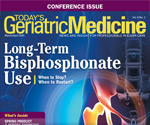 |
A new study estimated the advanced glycation end product (AGE) content of diets in various countries, examining the link between dietary factors and the risk of developing Alzheimer’s disease. Findings indicated that the higher the cooking temperatures of a food, the higher the AGE content.
Experimenting in mice, researchers found that those consuming a diet high in AGEs, similar to a Western diet, had high levels of AGEs in their brains along with deposits of amyloid-ß, a component of the plaques characteristic of Alzheimer’s disease. They also experienced cognitive and motor ability declines. Mice on a low-AGE diet remained free from similar declines.
In addition to reading our e-newsletter, be sure to visit Today’s Geriatric Medicine’s website at www.TodaysGeriatricMedicine.com, where you’ll find news and information that’s relevant and reliable. We welcome your feedback at TGMeditor@gvpub.com. Follow Today’s Geriatric Medicine on Facebook and Twitter, too.
— Barbara Worthington, editor |
 |
 |
Study Suggests Role of Dietary Advanced Glycation End Products
in Risk of Alzheimer’s Disease
A new paper published in the Journal of Alzheimer’s Disease provides evidence that cooking foods at high temperatures increases the risk of Alzheimer’s disease. This study examined the content of advanced glycation end products (AGEs) in national diets and clinical studies and compared total AGEs to Alzheimer's disease rates.
AGEs are a group of compounds that are combinations of sugars and proteins and other large molecules. They can be formed in the body, and there is a large body of literature on AGEs and Alzheimer's disease. However, AGEs are also formed when food is cooked at high temperatures or aged for a long period, such as in hard cheese. AGEs increase the risk of various chronic diseases through several mechanisms including increased inflammation and oxidative stress. They can also bind to the receptor for AGEs (RAGE). RAGE transports beta-amyloid proteins across the blood-brain barrier and contributes to the development of Alzheimer’s disease.
Full story » |
 |
 |
Alzheimer's Diagnosis in Primary Care
The National Institute on Aging-Alzheimer's Association guidelines provide clarity to primary care physicians regarding the diagnosis and treatment approach for patients with Alzheimer's disease and highlight the need for regular follow-up and management. Read more »
Physicians Promote Successful Aging
Physicians contribute to objective successful aging by providing good treatment and helping patients maintain good health and avoid illness, but health care providers typically pay inadequate attention to behavioral health issues. Read more »
Music and Art in Memory Care
Mather LifeWays art therapists combine music with art therapy to facilitate creative expression and connection for residents living with dementia. Read more » |
 |
 |
Doc, I Lost My Keys Again!
If only we had a nickel for every time we've heard this: "My memory isn't what it used to be, but, hey, I'm 75 now so what can I expect?" Great question. Are we destined to be more forgetful as we age? From time to time, most of us find ourselves misplacing something or forgetting a piece of information we thought we should remember. We sheepishly laugh and say, "I'm having a senior moment." But what really is happening?
As our bodies age physically, so do our brains. An older brain requires more attention to maintain good memories, and it may take longer to retrieve information we are trying to recall. Is that a function of the aging process? Or is that the beginning of dementia?
Continue reading » |
 |
|
|
 |
|
|
 |
 |
WalkJoy
By providing a signal to healthy nerves around the knee, WalkJoy replaces the sensation of feet striking the ground that has been lost to peripheral neuropathy. The signal enables the brain to respond as though there is no loss of sensation in the feet. Most patients see benefits within 30 to 50 steps and begin to regain strength after several weeks of increased activity. Each WalkJoy unit contains a small computer and sensors that measure the angle and speed during leg movements. As the foot strikes the ground, WalkJoy provides a vibrating or buzzing sensation to the nerves below the knee. These nerves have a dedicated pathway to the brain and are not affected by peripheral neuropathy. The device’s buzzing sensation replaces the pressure feeling formerly experienced when a patient’s feet struck the ground. Learn more »
ALLEVYN Life Dressing
ALLEVYN Life dressing is a multilayered design incorporating hydrocellular foam, hyper-absorber lock-away core, and a masking layer designed for people and their daily routines through a unique quadrilobe shape with a wide border designed to fit the contours of the human body more securely and allowing patients to shower. The protective masking layer minimizes the visual impact of strikethrough, providing the patient with confidence that the dressing may not attract the negative attention of others. It provides the patient with peace of mind regarding leakage prevention and offers wound odor absorption. The multilayered design provides cushioning and helps to distribute pressure. The silicone wound contact layer offers minimal pain and discomfort on removal. Learn more » |
 |
 |
 |
A Secure, Anonymous Résumé Bank
Job Alerts Sent to Your E-mail |
 |
|


